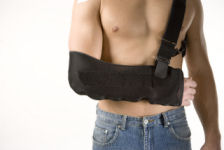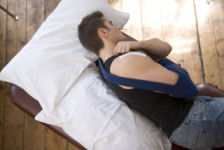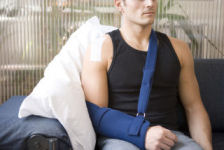Latarjet-Bristow Procedures
This procedure is mainly performed when there is some bone loss from the front of the glenoid (as a result of a bony bankart lesion or repeated dislocations wearing away the front of the glenoid).
It was first described by a french surgeon, Michel Latarjet, in 1954. Similar procedures have also been used such as the Bristow procedure in the UK and Boytchev procedure in Russia. Globally however, the Latarjet procedure has become the most popular procedure due to it's low recurrence rate and excellent published results.
The procedure involves transfer of the coracoid with it's attached muscles to the deficient area over the front of the glenoid. This replaces the missing bone and the transferred muscle also acts as an additional muscular strut preventing further dislocations. The procedure has a high success rate (recurrence rate of less than 1%4) and this is due to the ‘triple effect’ described by Patte. These are: 1) increase or restore the glenoid contact surface area; 2) the conjoint tendon stabilises the joint when the arm is abducted and externally rotated, by reinforcing the inferior subscapularis and anteroinferior capsule; 3) repair of the capsule. This triple effect is why the Latarjet is such a successful procedure.
Procedure
There are a few modifications of the original techniques described by Latarjet. We use a congruent arc technique (developed by Joe DeBeer), which increases the joint surface contact area, enhancing the joint stability. It has the advantages of improving both the bony and soft tissue problems, with a strong fixation, allowing early active rehabilitation.
Another common technique is that described by Walch & Boileau.
The Bristow procedure is less common nowadays, but still may be performed
Your Operation
You must not eat or drink anything after midnight the day before your surgery. When you wake up following the procedure you will be wearing a sling (see picture), which you should keep for 3-6 weeks. For more details on Living with a Shoulder Sling CLICK HERE
You may be in hospital overnight after your operation. A physiotherapist will see you in hospital to teach you the appropriate exercises. You may also see an occupational therapist to give you advice regarding the use of your arm.

PAIN
A nerve block may be used during the surgery. This means that immediately after the operation the shoulder and arm often feel completely numb. This may last for a few hours. After this the shoulder may well be sore and you will be given painkillers to help this whilst in hospital. These can be continued after you are discharged home. Ice packs may also help reduce pain. Wrap crushed ice or frozen peas in a damp, cold cloth and place on the shoulder for up to 15 minutes. Ensuring you cover the wound site with a piece of cling film to keep the area dry.
For more information on Pain Control Click Here
THE WOUND
You will have a surgical incision at the front of your shoulder. The stitch is dissolvable and is usually removed or trimmed at 3 weeks. Keep the wound dry until it is well healed. This usually takes 2 weeks.

surgical wound one year after Latarjet procedure
SLEEPING
For the first three weeks your sling should be worn in bed. Sleeping can be uncomfortable if you try and lie on the operated arm. We recommend that you lie on your back or on the opposite side, as you prefer. Ordinary pillows can be used to give you comfort and support. If you are lying on your side one pillow slightly folded under your neck gives enough support for most people. A pillow folded in half supports the arm in front and a pillow tucked along your back helps to prevent you rolling onto the operated shoulder during the night. If you are lying on your back, tie a pillow tightly in the middle (a "butterfly pillow") or use a folded pillow to support your neck. Place a folded pillow under the elbow of the operated arm to support that.



FOLLOW UP APPOINTMENTS
An appointment will be made for you to see the surgeon or specialist therapist 3-6 weeks post-operatively.
DAILY ACTIVITIES
For the first three weeks all activities of daily living for example feeding, dressing, cooking etc must be carried out using your un-operated arm. If appropriate an occupational therapist will be available to give you advice on how to do this.
LEISURE ACTIVITIES
Your physiotherapist and surgeon will advise you when it is safe to resume your leisure activities . This will vary according to your sport and level, as well as the period required to retrain your shoulder muscles with physiotherapy.
Below is a rough guide:
An appointment will be made for you to see a physiotherapist after your discharge and you will be seen by the Shoulder Team 3 weeks post-operatively.
DAILY ACTIVITIES
For the first six weeks all activities of daily living for example feeding, dressing, cooking etc must be carried out using your un-operated arm. If appropriate an occupational therapist will be available to give you advice on how to do this.
LEISURE ACTIVITIES
Your physiotherapist and surgeon will advise you when it is safe to resume your leisure activities . This will vary according to your sport and level, as well as the period required to retrain your shoulder muscles with physiotherapy.
Below is a rough guide:
| Swimming | Breastroke Freestyle |
6 weeks 3 months |
| Golf | 3 months | |
| Contact Sport | Includes rugby, horse riding, football, martial arts, racquet sports, and rock climbing | 3 months |
DRIVING
You will not be able to drive for a minimum of 8 weeks. Your surgeon will confirm when you may begin.
RETURNING TO WORK
This will depend upon the size of your tear and your occupation. You will need to discuss this with your surgeon.
For the post-operative rehabilitation
click here
Also See:
Bibliography
- De Beer JF., Roberts C. Glenoid Bone Defects - Open Latarjet with Congruent Arc Modification. Orthop Clin N Am. 2010; 41: pp407-415
- Allain J., Goutallier D., Glorian C. Long term results of the Latarjet procedure for the treatment of anterior instability of the shoulder. J Bone Joint Surg Am. 1998; 80: pp841-852
- Bradley-Edwards T., Walch G. The latarjet procedure for recurrent anterior shoulder instability: rationale and technique. Operative techniques in Sports Medicine. 2002; 10(1): pp25-32


